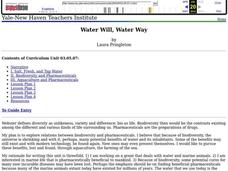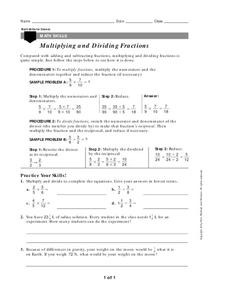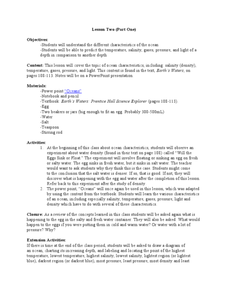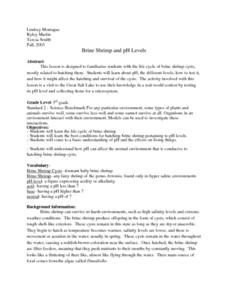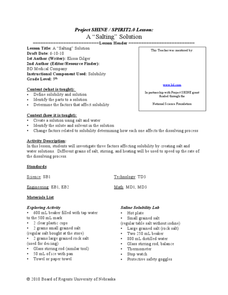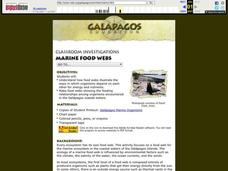Curated OER
Water Will, Water Way
Young scholars test tap water for hardness and mineral content. In this environmental science lesson plan, students identify the different stages of the water cycle. They classify plant and animals according to the rules of taxonomy.
Curated OER
Mixture Word Problems
In this algebra worksheet, students solve word problems related to mixtures. They figure out cost per kg, concentration of chemicals and percent of mixtures. There are 12 problems with an answer key.
Curated OER
Multiplying and Dividing Fractions
In this algebra instructional activity, students review numerators and denominators. They practice solving fractions using multiplication and division. There are 6 questions including two word problems.
Curated OER
What on Earth is That and How Can I Get One?
Students examine how we use submersibles. In this technology based lesson, students examine various technologies used by submersibles in ocean exploration.
Curated OER
The Open Ocean, What is it and How Does it Change?
Students investigate the ocean environment. In this ocean instructional activity, students discover the physical properties of the ocean. Over two days, students work in small groups investigating ocean maps and creating water currents.
Curated OER
What Lives in the Open Ocean and Where Do They Live?
Young scholars explore oceanography by participating in a flash card activity. In this ocean inhabitant instructional activity, students define a list of ocean related vocabulary terms and answer ocean geography study questions. Young...
Curated OER
Desalination: Creating a Solar Still
To better understand how solar power can aid in creating desalinated drinking water, the class creates a model still. They will build a model of a solar still, make observations, and discuss how the process works. While the idea behind...
Curated OER
Texas Estuary Project
Students take a field trip to a local estuary and analyze water samples. They analyze and graph the data results, write an essay, and create a food web of their field site.
Curated OER
Composting in Schools: Observing Compost Microorganisms
Students explore composting. In this composting instructional activity, students use compound microscopes to observe the microbial communities in compost. Observations and documentation of changes will occur over the course of several...
Curated OER
Water Currents
Pupils demonstrate how ocean currents are influenced by changes in density. They discover that temperature and salintiy affect density as well. They participate in a short experiment to end the lesson.
Curated OER
Lesson tow
Students study the ocean and its characteristics. In this oceans instructional activity students complete a lab activity and are able to predict temperature of certain depths.
Curated OER
Systems of Equations: Substitution Method
In this systems of equations worksheet, students solve 6 systems using the substitution method. Students then set up and solve 2 systems of equations word problems, one being a mixture problem.
Curated OER
WONDERFUL, WATERFUL WETLANDS
Students list characteristics of wetland and describe the functions of a wetland.
Curated OER
Brine Shrimp And Ph Levels
Third graders investigate the different ph levels found in water that is tested using simple measurements. The water samples are taken from a local body of water. The ph levels are used to help indicate areas where shrimp can thrive in...
Curated OER
Got Water?
Students determine that delivering clean, fresh water to citizens around the world involves and affects politics, economics, international relations, and technology. They brainstorm a list of factors that might affect their town's...
Curated OER
Earth & Beyond: Dryland Salinisation
For this earth and beyond worksheet, students read information about dryland salinsation, a serious problem facing Western Australia, and then answer 14 questions about the topic.
Curated OER
Why is the Ocean Salty?
In this ocean salt learning exercise, students read about the processes that have lead to the salt content in the ocean. Then students complete 5 short answer questions.
Curated OER
A “Salting” Solution
Ninth graders investigate the factors affecting solubility. For this chemistry lesson, 9th graders differentiate solvent and solute. They give examples of real world application of solutions.
Curated OER
Salt is Good On Sunflower Seeds, But What About Cypress?
Students record their observations about growing a cypress plant and putting salt in the plant. In this cypress plant lesson plan, students observe and record what is happening as the cypress plant grows. This gives directions for...
Curated OER
Inquiry-based Investigations into Pond Water Microorganisms
Students become familiar with common microorganisms and experience exploring the microbial world.
Curated OER
Adventures With Super-Absorbers and Substance Solubility
Students understand the concepts of absorption, swellability and solubility and recognize that science is all around us in our everyday lives and is fun to explore.
Curated OER
Observing Brine Shrimp
Students observe brine shrimp eggs, create an appropriate environment for their survival, and observe their growth.
Curated OER
Marine Food Webs
Students examine how food webs illustrate the ways in which organisms depend on each other for energy and nutrients, and make food webs showing the feeding relationships among organisms encountered in the Gal??pagos coastal waters.
Curated OER
Early Arkansas Geography
Seventh graders locate and describe historical Arkansas while using a historical map.
Other popular searches
- Salinity in the Oceans
- Properties of Water Salinity
- Ocean Salinity
- And Salinity
- Soil Salinity
- Salinity and Density
- Science Salinity
- Salinity of Streams
- Dry Land Salinity
- Salinity Brine Shrimp
- Salinity Hydrometer
- Icebergs and Salinity
